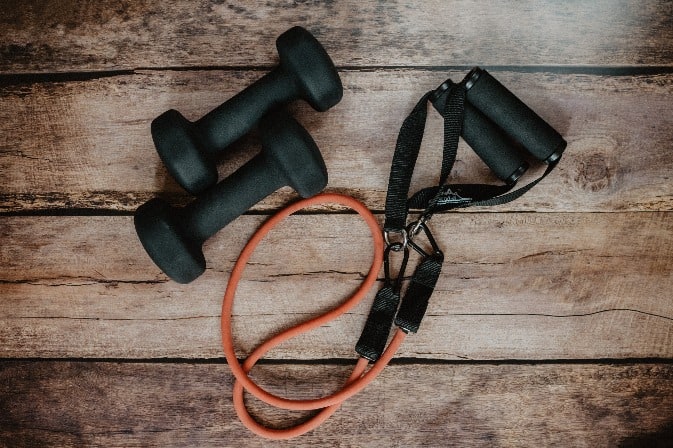 Desk jobs are not known to be good for our health. Too much sitting combined with a calorie-rich, nutrient-poor diet is making us sicker with each decade. And the number one excuse for not exercising is “not enough time”. We all know we need to move more but how do we do it with such busy lives? Well, we can exercise at work for starters!
Desk jobs are not known to be good for our health. Too much sitting combined with a calorie-rich, nutrient-poor diet is making us sicker with each decade. And the number one excuse for not exercising is “not enough time”. We all know we need to move more but how do we do it with such busy lives? Well, we can exercise at work for starters!
When you work all day your time at home is precious, no matter who you are. If you have a family, they need your attention. And if you don’t have a family, I’m guessing you still have plenty of other things to do with your time! So my solution is to do some exercise at work then you can focus on all the other things at home.
But even for those of you that no longer work, you can use these same ideas at home during the day. I work from home and it’s very easy to spend a large portion of the day sitting at my computer reading and writing. In fact, I came up with these to help myself be more active while I’m at home!
I often think people miss opportunities to multitask when it comes to exercise and healthy living. And this is a prime example. My goal as a coach is to help women find easy ways to fit exercise into their daily routines. That way they’re more likely to get it done.
So I’m giving you my list of ideas for how you can exercise at work during the day. This includes both strength training and cardio. These exercises obviously won’t be high-intensity or long workouts since they’ll be happening during your workday. But they’re still very effective for helping with weight loss and achieving better health.
Be prepared to exercise at work

To begin with, you need to be prepared ahead of time if you want to exercise at work. Assuming you don’t have a fitness room or locker at your workplace you need to bring along a bag with a few necessary items.
Depending on what you decide to do for exercise during the day there are several things you might want to add to your bag.
-
- Baby wipes are great for a quick clean-up after a workout! If you don’t have a private bathroom to use at work baby wipes are easy to use in a public restroom.
- Tennis shoes will be necessary if you plan to do some walking or stair climbing for cardio. I would NOT recommend any serious walking in dress shoes or heels (they’re very bad for your feet)! If you have a casual workplace, just get a nice pair of athletic shoes to work in.
- A t-shirt might be nice to have for your cardio session so you don’t end up sweating in your work shirt. Better to be safe than sorry and stinky!
- Deodorant: no explanation necessary!
And finally, you might want a few exercise accessories to keep at work to use during the day. Light dumbbells or bands are easy to transport and store. But you could always just focus on bodyweight exercises so you don’t have to bother.
Once you get these items together, keep them in a bag so you don’t forget anything. Forgetting something important will discourage you from exercising at all. Part of getting healthy and creating new habits is learning to be prepared and overcoming obstacles. So plan ahead.
Set an hourly timer
It’s a fact, not an opinion, that too much sitting during the day is bad for your health. It’s associated with all the major health problems including obesity, cardiovascular disease, Type 2 Diabetes, and some cancers. But how do you avoid sitting when you have a desk job?
For starters, we need a signal to remind us to get up and move once every hour and each of us needs to figure out what that signal will be. You can set a timer on your phone or computer, or just put up a sticky note to remind you to get up and move for just 3 minutes every hour.
During those 3 minutes, you can focus on a few different exercises to work through. Take a little walk first as a warm-up; go to the bathroom, or go get more water. Then go back to your desk and do some exercises for the next couple of minutes.
“60 to 75 minutes of moderate-intensity exercise per day were sufficient to eliminate the increased risk of early death associated with sitting for over eight hours per day.” This was reported in Sciencedaily.com from an analysis of 16 studies published by The Lancet.
Depending on your schedule, you could get over half that amount of physical activity just at work! And when you’re not at work, focus on being up on your feet and moving more than sitting. That way, you’ll burn more calories and keep your muscles active.
Types of exercises
Any good exercise program involves both cardio and strength training. Cardio helps your heart and vascular system. Strength training works all your other muscles, but also helps your joints and bones. They’re both important for improving your quality of life, plus keeping you independent and safe as you’re aging.
Walk for exercise at work
It’s easy to get some cardio at work by taking some walks in your building or outside on a break. Most people get a couple of breaks during the day and this is the perfect time to go for a short 10-15 minute walk. It’ll also help wake you up and energize you!
These walks don’t have to be power walks either. Just get out of your chair and get moving rather than sitting all day. The minimum recommendation for cardio is to do 150 minutes a week (but more is always better!). That translates to 30 minutes on each of the 5 days of your workweek.
You can also just jog, march, or dance in place for a minute or two at your desk. You can always go to the breakroom or restroom if you feel like a fool jogging next to your desk. Or be a real leader and let everyone see you. It might inspire your coworkers to get up and move too!
If you have a full hour for lunch then skip eating out and bring your own healthy meal from home. This will give you time to walk for half an hour but still have enough time to eat without rushing too much.
Restaurant and processed foods are where we get most of our extra salt, sugar, and fat anyway. So it’s better to stay away from them.
Climb stairs or stand and move at your desk
 An even better option for exercising at work is to climb stairs for a couple of minutes. This will really get your heart rate up but also be an excellent leg workout at the same time. Hitting two birds with one stone is a better use of time!
An even better option for exercising at work is to climb stairs for a couple of minutes. This will really get your heart rate up but also be an excellent leg workout at the same time. Hitting two birds with one stone is a better use of time!
You could also make it a rule to stand up every time you get on the phone or while you’re just reading. Why not deliver a message to a coworker in person rather than by email? Be creative and use the resources you have to get yourself moving more during the day. Any movement is better than none at all.
Related article: Why do cardio for exercise?
Strength exercises at work
Every hour when you stand up take a short walk first, or march at your desk to get your blood flowing. Then do some strength moves there or in the breakroom. These should include:
-
- Lower body exercises
- Upper body exercises
- Core exercises
I think the smartest schedule is to work your upper body muscles Monday, your lower body Tuesday, and your core on Wednesday. Then start that routine over again on Thursday. That way you’re doing something every day and your body needs that. If any muscles are sore the next day then give them a rest for a day.
You want to be sure to do strength training to build more muscle. When you have more muscle your body naturally burns more calories! You’ll also get stronger and start to look more toned which is what we want right? So don’t skip this important part of training.
Related article: 5 Benefits of strength training for women
List of strength exercises
You can do any strength exercises you want but here are my examples to get you started. I like these because they’re basic yet they work most of your body parts. Remember to do all of these exercises slowly for best results and keep your back straight in all of these examples, especially when you’re bent over.
FYI: the underlined words contain a link to send you to a Youtube video showing you how to do the exercise properly.
Upper body exercises
-
- Desk push-ups. Place your hands on the edge of your desk and move your feet out away from your desk so your chest is leaning toward it. From there, do 10-20 push-ups keeping your elbows close to your body.
- Bicep curls. Stand straight up with your arms down to each side. Holding a band or a heavy object, bend your arm at the elbow and raise the object up toward your chest. Lower and repeat 10-20 times then switch to your left arm.
- Front arm raises. Stand and hold a book, stapler, or another slightly heavy item in each hand while doing this one. Raise your straight arm out in front of your body to shoulder height and lower 10-20 times. Do one arm at a time if you only have one item to hold.
- Side arm raises. Holding that same book/item in one hand, lift one arm straight up to the side, no higher than shoulder height, and lower again. Repeat 10-15 times then do the other arm.
- Back arm raises. Using that same heavy item, bend forward slightly and raise your straight arm toward the back 10-20 times. Repeat with your other arm.
- Bent over rows. Bend over and place your left hand on your chair. With your purse or a heavy book in your right hand, lift your right elbow toward the back as if you were a puppet and there’s a string attached to it lifting up just your elbow (not your hand). Your arm should be bent at 90 degrees when you lift your elbow. Keep your elbow close to your body and repeat this move 10-20 times.
Lower body exercises
It’s actually easier to do lower body exercises at work since you really don’t need any extra weight to accomplish them. When working our legs we already have our upper body weight pushing down on them so extra weights aren’t necessary to start.
-
- Leg lifts. Lift one leg straight up to the front and lower, then straight out to the side and lower, then out to the back and lower about 10-20 times. Repeat with the other leg.
- Heel raises. Stand with feet about shoulder-width apart. Raise up onto your toes (lifting your heel up) and lower about 10-20 times. You could also just jump in place and work those calves even more!
- Regular squats. Stand with feet about shoulder-width apart again. Push your butt back and bend your knees to lower yourself down to a proper squat position. You don’t have to bend all the way to 90 degrees at your knees. Just go as far as you can. Your knees should not go past your toes and your weight should be on your heels. Keep your back straight and try for 15-20 reps.
- Knee raises. Stand with feet about should-width apart and raise up one knee at a time as high as you can. Alternate from the right to the left knee and do 15-20 reps. This exercise can also be done for at least 1-2 minutes at a time while you read or talk on the phone.
- Fast feet. Stand with feet close together and step out to the right then to the left, then in again with the right, and in with the left. Do this as fast as you can for 30 seconds or more. This is also a cardio move so you’ll start to breathe harder and sweat if you do it long enough!
- Sumo (or wide-leg) squats. Stand with feet wider than shoulder-width and toes pointing out diagonally. Bend your knees and lower yourself down while keeping your back straight and mostly upright. You’ll be using the muscles on the inside of your thighs more with this squat. Do 15-20 reps.
Standing core exercises at work
When you’re doing the upper and lower body exercises you’ll naturally be using your core to accomplish many of them. But since our core muscles are the foundation of our body we should work them separately on a weekly basis too.
These are all standing exercises since you’re at work and don’t need to be getting down on the floor!
-
- Knee to opposite elbow. Stand with feet should-width apart and hands behind your head. Raise your left knee toward your right elbow and bend forward just slightly to try to touch your elbow to your knee. Then switch to your right knee and left elbow. Do 10-20 alternating reps.
- Knee to same elbow. In the same position, raise your left knee to your left elbow then your right knee to your right elbow. Do 10-20 alternating reps.
- Back arch with leg lift. In the same position again, extend one leg out back and pull both elbows back pinching your shoulder blades together at the same time. Do 10-20 reps.
Try to do 3 sets of each of these exercises throughout your day.
How to structure your exercises
Choose just 2-3 of these exercises to do in your three minutes of moving every hour. Once you’ve worked through them all at different breaks, then you can start over for a second set if your muscles feel like they can handle it. Then move on to a third set if you’re able.
The principle of progressive overload tells us that muscles will grow when we continually challenge them in new and different ways. The first challenge to work on is sets and repetitions. My exercise examples show 3 sets of about 10-20 reps.
Concerning sets, you should only do 3 if you can maintain proper form. Once you start to get sloppy, or it just feels too hard, then you quit. If you can only get through 2 sets in the beginning that’s fine. Keep at it and work your way up to 3 sets as you get stronger.
When it comes to repetitions, it’s the same idea; do as many as you can with good form. Work your way up from 3 sets of 10 reps to 3 sets of 20 reps over time.
Once you can do 3 sets of 20 reps, then you move on to using a slightly heavier weight. But then you start over again with just 3 sets of 10 reps at the new weight and work your way back up to 20 again. Every time you get to 3 sets of 20 then you can move up to a heavier weight. Be sure to only raise your weights by 1-2 lbs each time.
This is why it might be helpful to bring in some dumbbells so you know what weight you’re actually lifting. That way you know how much weight to add when you’re ready to move up. The more consistent you are at doing these exercises, the quicker you’ll make gains and progress to more weight.
It’s also a good idea to write these exercises down and keep track of how many sets and reps you do each day. Then you can see exactly how much you’ve progressed over time.
What you should know about exercise in general
I know you’re so used to sitting all day long that adding these exercises to your workday may seem overwhelming at first. I always say that what we mostly do begets more of the same. In other words, sitting makes you want to sit more while being active leads to having more energy for more activity.
So in the beginning you may have to force yourself to get up and move more because you’re not used to it. But it will pay off and your body will get used to it! As your body gets used to doing more you’ll feel more like getting up and moving. Exercise actually gives you more energy in the long run, but it takes some time.
Low-intensity endurance exercise burns mostly fat. So cardio, or just moving more, will help you burn off those calories that your body already stored away. This is why cardio is so important for weight loss besides making your heart stronger.
Strength training on the other hand builds muscle and muscle burns more calories overall than fat. So be sure to start using your muscles in new and unique ways to challenge them to grow. Once you’ve done these exercises for 8-10 weeks, find different ones so your muscles get a new challenge.
Moving more throughout the day should also help you to sleep better at night. And that will help to motivate you to move more in the future! I don’t have to tell you that when you sleep better you feel better and have more energy.
Eating healthy snacks and meals during your day is another great way to fuel your body with energy and motivation. So plan your meals and snacks ahead of time in order to get the most out of your food. Give up on the junk from the vending machine at break time and eat an apple or a handful of nuts instead!
My final thoughts
If you want to lose weight and start feeling better then these exercises at work are a great starting point. If you haven’t been exercising at all then starting a work exercise routine can help you get fit enough to do a harder workout at home occasionally. It’s a snowball effect.
During your off-work hours, you can also choose to do activities that are more fun with your family or friends. Walking with a friend doesn’t seem like exercise at all and biking is more fun than it is work. Unless you live in the mountains!
Here’s a great video on the obesity epidemic in our country and how our sedentary habits are NOT helping us. I believe that we mostly sit because we can. We’ve gotten into the habit of sitting for everything and now it just seems normal to sit most of the time.
You have to change your environment and your habits if you want the benefit of better health and lower weight. Commit to these exercise-at-work tips for 2 months and see for yourself what improvements you notice. Doing anything different is better than mindlessly doing the same things over and over!
Even if you don’t lose much weight, your body will be in better shape simply because you’re using it more. Keep in mind that it’s more about your overall health and quality of life than it is about your looks. By moving more and making small changes in your dietary choices you’ll end up feeling better and being sick less often.
Pay attention to your moods before and after you exercise. You might realize how true it is that you can actually ease anxiety and stress with exercise. Then maybe you won’t feel compelled to eat junk or drink alcohol for comfort! Feeling better leads to a happier more satisfying life! That’s what it’s all about.
Let me know in the comments below if you’ve come up with any creative ways to exercise at work and how that’s going for you!

